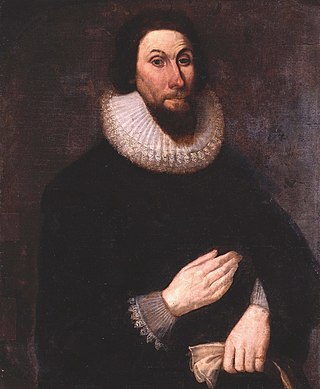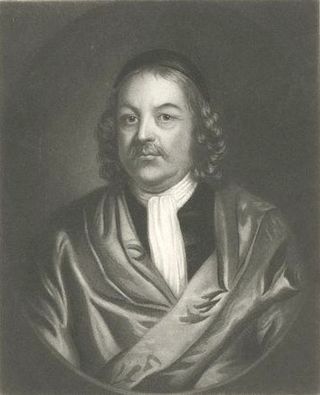Related Research Articles

John Winthrop was an English Puritan lawyer and one of the leading figures in founding the Massachusetts Bay Colony, the second major settlement in New England following Plymouth Colony. Winthrop led the first large wave of colonists from England in 1630 and served as governor for 12 of the colony's first 20 years. His writings and vision of the colony as a Puritan "city upon a hill" dominated New England colonial development, influencing the governments and religions of neighboring colonies in addition to those of Massachusetts.

The Massachusetts Bay Colony, more formally the Colony of Massachusetts Bay, was an English settlement on the east coast of North America around the Massachusetts Bay, the northernmost of the several colonies later reorganized as the Province of Massachusetts Bay. The lands of the settlement were in southern New England, with initial settlements on two natural harbors and surrounding land about 15.4 miles (24.8 km) apart—the areas around Salem and Boston, north of the previously established Plymouth Colony. The territory nominally administered by the Massachusetts Bay Colony covered much of central New England, including portions of Massachusetts, Maine, New Hampshire, and Connecticut.

Theophilus Eaton was a wealthy New England Puritan merchant and diplomat. He was a founder and eventual governor of New Haven Colony, and a founder of the Massachusetts Bay Colony. His brother, Nathaniel Eaton, was the first headmaster of Harvard College.

The Winthrop Fleet was a group of 11 ships led by John Winthrop out of a total of 16 funded by the Massachusetts Bay Company which together carried between 700 and 1,000 Puritans plus livestock and provisions from England to New England over the summer of 1630, during the first period of the Great Migration.

The Province of Massachusetts Bay was a colony in New England which became one of the thirteen original states of the United States. It was chartered on October 7, 1691, by William III and Mary II, the joint monarchs of the kingdoms of England, Scotland, and Ireland, and was based in the merging of several earlier British colonies in New England. The charter took effect on May 14, 1692, and included the Massachusetts Bay Colony, the Plymouth Colony, the Province of Maine, Martha's Vineyard, Nantucket, Nova Scotia, and New Brunswick; the Commonwealth of Massachusetts is the direct successor. Maine has been a separate state since 1820, and Nova Scotia and New Brunswick are now Canadian provinces, having been part of the colony only until 1697.

Thomas Dudley was a New England colonial magistrate who served several terms as governor of the Massachusetts Bay Colony. Dudley was the chief founder of Newtowne, later Cambridge, Massachusetts, and built the town's first home. He provided land and funds to establish the Roxbury Latin School, and signed Harvard College's new charter during his 1650 term as governor. Dudley was a devout Puritan who was opposed to religious views not conforming with his. In this he was more rigid than other early Massachusetts leaders like John Winthrop, but less confrontational than John Endecott.
John Haynes, also sometimes spelled Haines, was a colonial magistrate and one of the founders of the Connecticut Colony. He served one term as governor of the Massachusetts Bay Colony and was the first governor of Connecticut, ultimately serving eight separate terms. Although Colonial Connecticut prohibited Governors from serving consecutive terms at the time, "John Haynes was so popular with the colonists that he served alternately as governor and often as deputy governor from 1639 to his death in 1653."

Joseph Dudley was a colonial administrator, a native of Roxbury in Massachusetts Bay Colony, and the son of one of its founders. He had a leading role in the administration of the Dominion of New England (1686–1689) which was overthrown in the 1689 Boston revolt. He served briefly on the council of the Province of New York where he oversaw the trial which convicted Jacob Leisler, the ringleader of Leisler's Rebellion. He then spent eight years in England in the 1690s as Lieutenant-Governor of the Isle of Wight, including one year as a Member of Parliament for Newtown. In 1702, he returned to New England after being appointed governor of the Province of Massachusetts Bay and Province of New Hampshire, posts that he held until 1715.

Simon Bradstreet was a colonial magistrate, businessman, diplomat, and the last governor of the Massachusetts Bay Colony. Arriving in Massachusetts on the Winthrop Fleet in 1630, Bradstreet was almost constantly involved in the politics of the colony but became its governor only in 1679. He served on diplomatic missions and as agent to the crown in London, and also served as a commissioner to the New England Confederation. He was politically moderate, arguing minority positions in favor of freedom of speech and for accommodation of the demands of King Charles II following his restoration to the throne.

William Stoughton was a New England Puritan magistrate and administrator in the Province of Massachusetts Bay. He was in charge of what have come to be known as the Salem Witch Trials, first as the Chief Justice of the Special Court of Oyer and Terminer in 1692, and then as the Chief Justice of the Superior Court of Judicature in 1693. In these trials he controversially accepted spectral evidence. Unlike some of the other magistrates, he never admitted to the possibility that his acceptance of such evidence was in error.

Arbella or Arabella was the flagship of the Winthrop Fleet on which Governor John Winthrop, other members of the Company, and Puritan emigrants transported themselves and the Charter of the Massachusetts Bay Company from England to Salem between April 8 and June 12, 1630, thereby giving legal birth to the Commonwealth of Massachusetts. John Winthrop is reputed to have given the famous "A Model of Christian Charity" sermon aboard the ship. Also on board was Anne Bradstreet, the first European female poet to be published from the New World, and her family.
Increase Nowell, (1590–1655), was a British colonial administrator, original patentee of the Massachusetts Bay Company, founder of Charlestown, Massachusetts, and first ruling elder of the First Church in Charlestown.
The Revd Isaac Johnson, a 17th-century English clergyman, was one of the Puritan founders of Massachusetts and the colony's First Magistrate.
Matthew Cradock was a London merchant, politician, and the first governor of the Massachusetts Bay Company. Founded in 1628, it was an organization of Puritan businessmen that organized and established the Massachusetts Bay Colony. Although he never visited the colony, Cradock owned property and businesses there, and he acted on its behalf in London. His business and trading empire encompassed at least 18 ships, and extended from the West Indies and North America to Europe and the Near East. He was a dominant figure in the tobacco trade.

Waitstill Winthrop was a colonial magistrate, military officer, and politician of New England.
English colonist William Vassall (1592–1656) is remembered both for promoting religious freedom in New England and commencing his family's ownership of slave plantations in the Caribbean. A patentee of the Massachusetts Bay Company, Vassall was among the merchants who petitioned Puritan courts for greater civil liberties and religious tolerance. In 1647, he and John Child published New-England’s Jonas cast up in London, a tract describing the efforts of colonial petitioners. By early 1648, Vassall moved to Barbados to establish a slave-labor sugar plantation. He and his descendants were among the Caribbean's leading planters, enslaving more than 3,865 people before Britain abolished slavery in 1833.
John Humphrey was an English Puritan and an early funder of the English colonisation of North America. He was the treasurer of the Dorchester Company, which established an unsuccessful settlement on Massachusetts Bay in the 1620s, and was deputy governor of the Massachusetts Bay Company from 1629 to 1630. He came to Massachusetts in 1634, where he served as a magistrate and was the first sergeant major general of the Ancient and Honorable Artillery Company. He became involved in English attempts to settle Providencia Island in the late 1630s, and returned to England in 1641 after financial reverses and probable religious differences with other members of the Massachusetts ruling elite. He then became involved in an attempt to settle The Bahamas in the late 1640s, and had some involvement in the politics of the English Civil War.

The Charter of the Massachusetts Bay Company was an English royal charter which formally incorporated the joint-stock company for the colonization of Massachusetts Bay. The charter, granted by Charles I of England in 1628, defined the regulations of the company, the land it would be granted, as well as the rights and privileges of the colonists.
References
- ↑ The Cambridge Agreement, West Windsor-Plainsboro Regional School District
- ↑ Thorpe, Francis Newton (18 December 1998). "The Charter of New England : 1620". avalon.law.yale.edu. Yale University. Retrieved 16 June 2023.